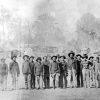calsfoundation@cals.org
Eagleton Carmichael (1828–1881)
Eagleton Carmichael was an officer in the Fifteenth Illinois Cavalry Regiment who saw extensive action leading expeditions from Helena (Phillips County) in pursuit of Confederate soldiers and guerrillas in Phillips, Lee, and Desha counties in 1863 and 1864.
Eagleton Carmichael was born in Knox County, Tennessee (though the 1860 census lists him as being born in Alabama), in 1828. Little is known about his early life, but by 1850 he was working as a carpenter in Metropolis, Illinois. He and his wife Jane had two sons.
When the Civil War began, Carmichael ran a mill in Metropolis and reported owning $2,500 in real estate and $300 in personal property. He was thirty-four years old and was recorded to be five feet eleven inches tall and had gray eyes, auburn hair, and a light complexion when he organized Carmichael’s Independent Cavalry Company. He was serving as the unit’s captain when he mustered into service on August 19, 1861. The company was designated Cavalry Company B and attached to the Twenty-ninth Illinois Infantry Regiment, serving with the Army of Tennessee and seeing action at Fort Donelson and Shiloh in Tennessee and at Corinth, Mississippi. Several cavalry companies, including Carmichael’s, were unattached from infantry regiments in the spring of 1863 and organized as the Fifteenth Illinois Cavalry Regiment. Carmichael was promoted to be the unit’s major on June 5, 1863.
The Fifteenth Illinois was transferred to the Union base at Helena in November 1863, and a unit history states that the troopers “did post duty and long severe scouting through Arkansas and Mississippi.” The first foray noted by The War of the Rebellion (the compiled official records of the Civil War) that was led by Carmichael in Arkansas was the November 14–17 expedition from Helena, but he would command dozens of scouting actions over the next several months, including one in which he captured noted guerrilla leader Tom Castile. The scouting expeditions of the Fifteenth Illinois would make hundreds of other Confederate soldiers and irregular troops prisoners of war.
While most of the fighting involving the Fifteenth Illinois consisted of skirmishing with Confederate soldiers and bushwhackers, the regiment was involved in one significant action, known as the Action at Wallace’s Ferry or the Action at Big Creek. Colonel William S. Brooks led around 280 men of the Fifty-sixth U.S. Colored Infantry, eighty from the Sixtieth U.S. Colored Infantry, and a two-gun section of Battery E, Second U.S. Colored Artillery out of Helena on July 25, 1864, accompanied by about 150 troopers under Carmichael, who would be taken by steamboat down the Mississippi River to work their way north to rejoin the Black soldiers. Brooks’s men were attacked by Colonel Archibald Dobbins’s First Arkansas Cavalry (CS) at Big Creek on the morning of July 26. The U.S. Colored Troops fought stubbornly but were close to being overwhelmed when Carmichael’s cavalry charged through Dobbins’s lines, and the combined command made its way back to Helena. Carmichael and the Fifteenth Illinois were widely credited with saving the day at Big Creek.
An officer from the office of the inspector general of the Military Division of West Mississippi, inspecting Union troops in Arkansas, on October 19, 1864, cited the Fifteenth Illinois as “quite deficient in drill, discipline, &c, but is of good material and needs a commanding officer of more force than Maj. E. Carmichael…who, although a good man, does not pretend to be proficient in drill.” Despite that, when several companies of the Fifteenth were combined with others of the Tenth Illinois Cavalry Regiment on January 27, 1865, to form the Tenth Illinois Veteran Volunteer Cavalry Regiment, Carmichael became the unit’s lieutenant colonel. He would serve with the regiment in Louisiana and Texas until it mustered out on November 22, 1865.
Carmichael returned to Metropolis, where he continued to run his mill and became a charter member of the Welcome Rebekah Degree Lodge of Freemasons. He was elected as Massac County treasurer but died in February 1881 before he could assume the office. He is buried in the Masonic Cemetery in Metropolis.
For additional information:
“15th Regiment, Illinois Cavalry.” National Park Service. https://www.nps.gov/civilwar/search-battle-units-detail.htm?battleUnitCode=UIL0015RC (accessed May 8, 2025).
“Col Eagleton Carmichael.” Find a Grave.com. https://www.findagrave.com/memorial/148976884/eagleton-carmichael (accessed May 8, 2025).
Delap, Fred, comp. Illinois Civil War Muster and Descriptive Rolls, Office of the Secretary of State of Illinois. https://apps.ilsos.gov/isaveterans/civilMusterSearch.do (accessed May 8, 2025).
“Gleanings from the Neighborhood.” Cairo [Illinois] Bulletin, February 20, 1881, p. 4.
Page, O. J. History of Massac County, Illinois, with Life Sketches and Portraits, Part One. Metropolis, IL: 1900.
Report of the Adjutant General of the State of Illinois, Vol. 8. Springfield, IL: Phillips Brothers, 1901.
The War of the Rebellion: A Compilation of the Official Records of the Union and Confederate Armies. Series 1, Vol. 41, Part 4, p. 103. Washington DC: Government Printing Office, 1893.
Mark K. Christ
Little Rock, Arkansas






Comments
No comments on this entry yet.